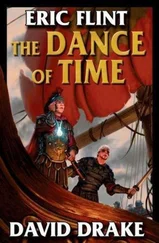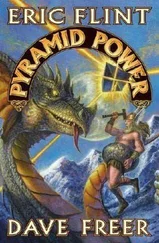Eric Flint - An Oblique Approach
Здесь есть возможность читать онлайн «Eric Flint - An Oblique Approach» весь текст электронной книги совершенно бесплатно (целиком полную версию без сокращений). В некоторых случаях можно слушать аудио, скачать через торрент в формате fb2 и присутствует краткое содержание. Жанр: Старинная литература, на английском языке. Описание произведения, (предисловие) а так же отзывы посетителей доступны на портале библиотеки ЛибКат.
- Название:An Oblique Approach
- Автор:
- Жанр:
- Год:неизвестен
- ISBN:нет данных
- Рейтинг книги:5 / 5. Голосов: 1
-
Избранное:Добавить в избранное
- Отзывы:
-
Ваша оценка:
- 100
- 1
- 2
- 3
- 4
- 5
An Oblique Approach: краткое содержание, описание и аннотация
Предлагаем к чтению аннотацию, описание, краткое содержание или предисловие (зависит от того, что написал сам автор книги «An Oblique Approach»). Если вы не нашли необходимую информацию о книге — напишите в комментариях, мы постараемся отыскать её.
An Oblique Approach — читать онлайн бесплатно полную книгу (весь текст) целиком
Ниже представлен текст книги, разбитый по страницам. Система сохранения места последней прочитанной страницы, позволяет с удобством читать онлайн бесплатно книгу «An Oblique Approach», без необходимости каждый раз заново искать на чём Вы остановились. Поставьте закладку, и сможете в любой момент перейти на страницу, на которой закончили чтение.
Интервал:
Закладка:
The phenomenon, they realized, was new to India. True, great empires had existed here before: the Gupta Empire, the immediate predecessor of the Malwa; and the even larger Mauryan empire of ancient history, which had encompassed most of India. But those empires, for all their size and splendor, had rested lightly on the teeming populace below. The Guptan and Mauryan emperors had made no attempt to interfere with the daily lives of their subjects, or the power and privileges of provincial satraps and local potentates. They had been satisfied with tribute, respect, submission. Beyond that, they had occupied themselves with their feasts, their harems, their elaborate hunts, and their great architectural projects. Even the greatest of those ancient rulers, the legendary Ashoka, had never tried to meddle with Indian customs and traditions beyond his patronage and support for the new Buddhist faith.
But, of course, neither the Guptan nor the Mauryan Empires had ever had the ambitions of the Malwa. The empires of the past were quite satisfied with ruling India, or even just northern India. They had not aspired to world conquest.
"All roads lead to Rome," Belisarius had murmured. "That's how the legions conquered the Mediterranean, and ruled it. The Malwa, it seems, intend to copy us."
Yes, the explanation fit. It fit, for instance, with the new bureaucracy which Belisarius and Garmat had noted in Bharakuccha. There had been much resentment and disaffection expressed, by the populace, toward that bureaucracy. It was impossible to miss, even from conversations in the streets. (Within a few years, Belisarius and Garmat had agreed, the conversations would be far less open; already the Malwa spies and provocateurs were doing their work.)
Strange new bureaucracy, by traditional Indian standards. Appointed by annual examinations, instead of breeding. True, most of the successful applicants were of brahmin or kshatriya descent, scions of one or another of the castes of those noblest of the four respectable classes, the twice-born varna . But there were vaisya bureaucrats also, and even—so it was rumored—a sudra official!
No untouchables, however. The Malwa regime was even harsher toward untouchables than tradition required. But that small bow toward hallowed custom brought little comfort to the twice-born. The Malwa were also grinding down the four respectable varna, among every people except the Malwa themselves and their privileged Rajput vassals. (And the Ye-tai, of course; but the barbarians had no proper varna and castes to begin with; uncouth, heathen savages.)
More and more sudra castes were finding themselves counted among the untouchables, now. Even, here and there, a few vaisya castes. As yet, the noble varna—the kshatriya and brahmin—seemed immune. But who was to know what the future might bring?
A much-hated new bureaucracy. Hated, but feared. For these new officials were armed with authority to override class and caste customs—overbearing and officious, and quick to exert their power against traditional satraps and long-established local potentates.
Great power, enforced by the Malwa weapons, and the massive Malwa army, and the privileged Rajput vassals, and the even more privileged Ye-tai. Enforced, as well, by their horde of spies and informants, and—worst of all—by the new religious castes: the Mahaveda priests and their mahamimamsa torturers.
For all the power of the new dynasty, however, it had become clear to Belisarius and Garmat that the process by which the Malwa were reshaping India was very incomplete. Incomplete, and contradictory. Much of the real power, they suspected, still lay in the hands of traditional rulers. Who chafed, and snarled, and snapped at the new officialdom.
True, they rarely rebelled, but the danger was ever present. Even at that moment, in fact, a great rebellion was taking place in the northern province whose capital was Ranapur. Their own expedition, eventually, was destined to arrive there. The emperor was overseeing the siege of Ranapur personally, which gave Belisarius and Garmat a good indication of how seriously the Malwa took the affair.
Following the surveyors and their elephant, a quarter mile back, came a party of Rajput horsemen. Two hundred of them, approximately, elite cavalry. Behind them came several elephants carrying pairs of huge kettledrums beaten by men on the elephants' backs. Then a party of footmen carrying flags.
Next—still out of sight from where they rode—came another troop of Rajput cavalry. Perhaps a hundred. Behind them came a larger contingent of Ye-tai cavalry.
The next stage of the caravan was within sight, and impossible to miss. Twenty war elephants, their huge heads and bodies protected by iron-reinforced leather armor. Each elephant was guided by a mahout and bore a howdah containing four Malwa kshatriya. The Malwa soldiers were not carrying rocket troughs, of course. Those weapons would panic the great pachyderms. Instead, they were armed with bows and those odd little flasks which Belisarius had pronounced to be grenades . The smaller variety of those grenades were bound to arrows. The larger variety, Belisarius explained, were designed to be hurled by hand.
Behind the troop of war elephants came Venandakatra himself, and his entourage of priests and mahamimamsa. The Mahaveda and the torturers rode atop elephants, four to a howdah. Occasionally, Venandakatra would do likewise. For the most part, however, the great lord chose to ride in a special palanquin. The vehicle was large and luxurious, borne by eight giant slaves. The palanquin was surrounded by a little mob of servants walking alongside. Some of the servants toted jugs of water and wine; others, platters of food; still others carried whisks to shoo away the ever present flies. Nothing was lacking for Venandakatra's comfort.
For the lord's nightly comfort, eight of his concubines rode in howdahs on two elephants, which followed Venandakatra's palanquin. The caravan would always halt at sunset and set up camp. Venandakatra's tent—if such a modest term could be used to describe his elaborate suite of pavilions—was always set up before he arrived. The lord possessed two such "tents." The one not being used was sent ahead, guarded by yet another troop of Rajput cavalry, to be prepared for the following night's sojourn.
The stage of the caravan which followed Venandakatra and his entourage was composed of Malwa infantry. No less than a thousand soldiers. The great number of them, presumably, was to compensate for their mediocre quality. These were not elite forces, simply a run-of-the-mill detachment from the huge mass of the Malwa army. The troops themselves were not Malwa, but a collection of men from various of the subject peoples. The officers were primarily Malwa, but not kshatriya.
Belisarius had been more interested in the infantry than in the elite cavalry units. The Ye-tai he understood, and, after some examination, the Rajput as well. They were impressive, to be sure. But Belisarius was a Roman, and the Romans had centuries of experience dealing with Persian cavalry.
But Belisarius thought the future of war lay with the infantry, and so he subjected the Malwa infantry to his closest scrutiny. It did not take him long to arrive at a general assessment.
Garmat expressed the sentiment aloud.
"That's as sorry a bunch of foot soldiers as I've ever seen," sneered the Ethiopian. "Look at them!"
Belisarius smiled, leaned over his saddle, and whispered:
"What tipped you off? Was it the rust on the spear blades? Or the rust on the armor?"
"Is that crap armor ?" demanded Garmat. "There's more metal on my belt buckle!"
"Or was it the slouching posture? The hang-dog expressions? The shuffling footsteps?"
"My daughter's footsteps were more assured when she was two," snorted the Ethiopian. "The sarawit would eat these clowns for breakfast."
Читать дальшеИнтервал:
Закладка:
Похожие книги на «An Oblique Approach»
Представляем Вашему вниманию похожие книги на «An Oblique Approach» списком для выбора. Мы отобрали схожую по названию и смыслу литературу в надежде предоставить читателям больше вариантов отыскать новые, интересные, ещё непрочитанные произведения.
Обсуждение, отзывы о книге «An Oblique Approach» и просто собственные мнения читателей. Оставьте ваши комментарии, напишите, что Вы думаете о произведении, его смысле или главных героях. Укажите что конкретно понравилось, а что нет, и почему Вы так считаете.










